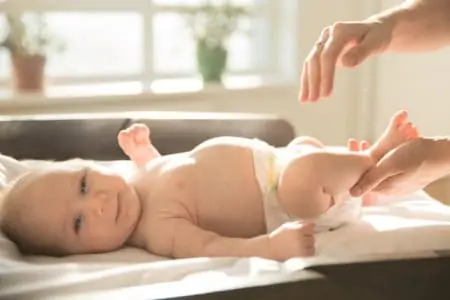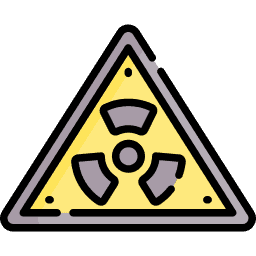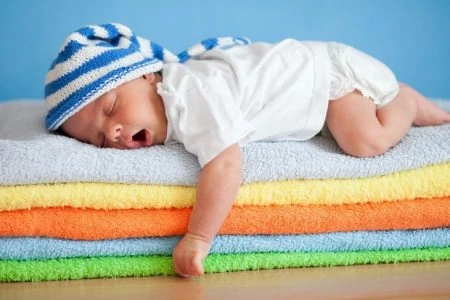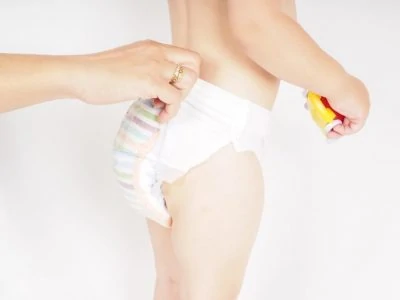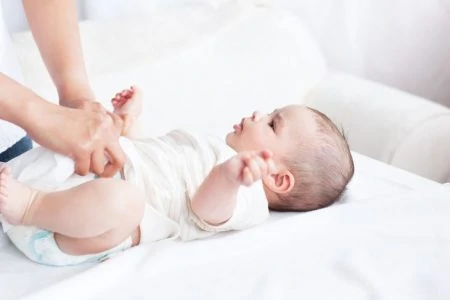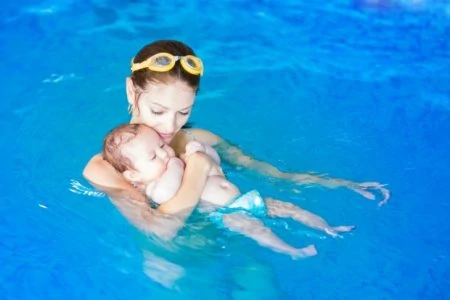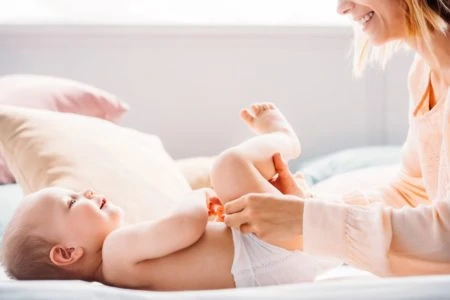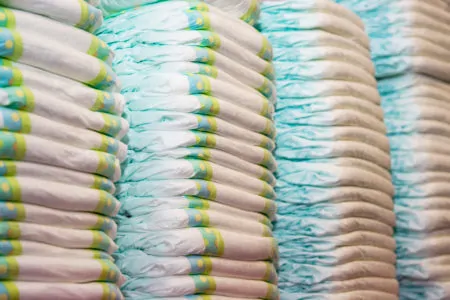Parenting involves an endless series of choices, and diapers are one of the biggest. If you worry about the chemicals touching your baby’s skin or the mountain of plastic waste they create, you might look for an organic or eco-friendly option. However, greenwashing is rampant, making it difficult to distinguish between truly sustainable brands and those just sporting a green leaf on the box.
We dug deep into ingredient lists, manufacturing processes, and certifications to cut through the noise. Combining expert insights with real-world parent feedback, we curated this list of the best organic diapers to help you make a cleaner choice for your baby and the planet.
- Excellent fit
- Independent certification
- Dye- & fragrance-free
- Only one wash before use
- Soft and comfortable outer layer
- Suitable for babies 10 lbs to 35 lbs
- FSC certified bamboo material
- Helpful wetness indicator
- Great for babies starting at 6lbs
- Color-coded sizing
- Soft bamboo-based material
- Made of 67% biodegradable materials
- Compostable packaging
- No inks or dyes
- Better for the environment
- High belly panel
- Caregiver-baby bonding design
- Good enough absorbency
- Ultra-absorbent
- Snug fit
- Petroleum-free materials
Why Choose Organic Diapers?
You might wonder if swapping to “greener” diapers actually makes a difference. While no disposable diaper is perfect, standard brands often rely heavily on petrochemicals and bleaches. Terms like “natural” or “eco-friendly” are loosely regulated, so knowing what to look for is crucial.
Here is why making the switch can be worth the extra cost:
Reduced Chemical Exposure
Standard disposable diapers often contain volatile organic compounds (VOCs) and traces of dioxins from chlorine bleaching. A French agency study found potentially unsafe levels of chemicals like glyphosate and phthalates in some conventional diapers (1).
Choosing brands that use Totally Chlorine Free (TCF) pulp and plant-based materials significantly lowers your baby’s daily exposure to these toxins.
Lower Allergy Risk
Diaper rash and contact dermatitis are often triggered by synthetic fragrances, dyes, or latex found in traditional diapers (2).
Organic brands typically skip the perfumes and unnecessary dyes. By eliminating these common irritants, you create a safer environment for sensitive skin to heal and breathe.
Environmental Impact
Traditional disposables use massive amounts of crude oil and wood pulp. It is estimated that one baby uses enough diapers to consume over 1,600 quarts of oil during their diapering years (3).
Eco-friendly brands often substitute plastic with bamboo or sustainably sourced wood pulp. This reduces the reliance on non-renewable resources and supports more sustainable forestry practices.
Key Features to Look For
We ignored the marketing fluff and evaluated diapers based on strict criteria. Here is what you should consider before buying:
Product Reviews
We evaluated absorbency, ingredient safety, and environmental claims to bring you the top choices for every budget and lifestyle.
DYPER Bamboo Baby Diapers
Best Overnight
DYPER is a standout brand that combines high performance with serious eco-credentials. The top and back sheets are crafted from 100% viscose from bamboo, which is soft to the touch, breathable, and naturally hypoallergenic.
Crucially, these diapers are Totally Chlorine Free (TCF), meaning no harmful dioxins are created during manufacturing. They are also free from alcohol, lotions, latex, and phthalates. This makes them a top-tier choice for babies with eczema or extremely sensitive skin.
One unique feature is the REDYPER service. For an additional fee, you can ship your soiled diapers back to the company for industrial composting, keeping them out of landfills entirely.
The fit is generous and flexible, thanks to the large hook-and-loop tabs. While they run slightly larger than standard brands, the deep pockets and double gussets do an excellent job of containing blowouts, even overnight.
Pros
- Certified Safe: OEKO-TEX Standard 100 certified.
- Compostable Option: Optional mail-back service for industrial composting.
- Sensitive Skin Friendly: Unscented, TCF, and incredibly soft bamboo.
Cons
- Sizing: Runs larger than brands like Huggies or Pampers.
Product Specs
| Liner | 100% Viscose From Bamboo Fibers |
| Pulp | Sodium Polyacrylate, Elemental Chlorine-Free Wood Pulp |
| Lotion | None |
| Fragrance & dyes | None |
| Packaging | Biodegradable plastic and cardboard |
Our Ratings
Smart Bottoms No-Prep Dream Diaper
Best Cloth
If you want to eliminate plastic waste entirely, the Smart Bottoms Dream Diaper is a fantastic cloth solution. Unlike many natural fiber cloth diapers that require multiple wash-and-dry cycles to become absorbent, this one is ready to go after just one wash.
The interior features certified organic cotton and hemp, materials that are gentle on the skin and highly absorbent. The snap-in insert system allows for easy cleaning and faster drying times compared to traditional All-In-Ones.
The outer waterproof layer is breathable and soft, ensuring your baby doesn’t overheat. Plus, the adjustable snap system means this single diaper can grow with your child from roughly 10 to 35 pounds, saving you money in the long run.
While the upfront cost is higher than a pack of disposables, the reusability factor makes it the most eco-friendly option on our list.
Pros
- Convenient: No complex prepping required; wash once and use.
- Natural Fibers: Organic cotton and hemp interior touches the skin.
- Adjustable: One-size design fits most babies through potty training.
Cons
- Fit Limitations: May be bulky on newborns under 10 lbs.
Product Specs
| Liner | Hemp & organic cotton. |
| Pulp | None |
| Lotion | None |
| Fragrance & dyes | None |
| Packaging | None |
Our Ratings
ECO BOOM Bamboo Biodegradable Diapers
Best Training
ECO BOOM has gained popularity for its simple, honest approach to diapering. Both the top sheet and back sheet are made from 100% bamboo viscose, which is naturally biodegradable and silky smooth against the skin.
The absorbent core utilizes FSC-certified wood pulp and high-quality SAP (Super Absorbent Polymer) to lock away moisture. We appreciate that they use Totally Chlorine Free (TCF) pulp, ensuring no nasty bleach byproducts.
These diapers include a wetness indicator, a helpful feature for sleep-deprived parents or those in the early stages of potty training. They are free from latex, PVC, TBT, and antioxidants, keeping the ingredient list clean.
While they market heavily on biodegradability, remember that in a standard landfill, degradation is slow. However, the reduction in plastic usage is still a significant win for the environment.
Pros
- Clean Materials: FSC certified bamboo and TCF pulp.
- User Friendly: Includes a wetness indicator.
- Broad Sizing: Available for babies starting at 6 lbs.
Cons
- Biodegradability: Like all disposables, requires specific conditions to degrade fully.
Product Specs
| Liner | 100% Bamboo |
| Pulp | “Fluff pulp” mixed with SAP |
| Lotion | None |
| Fragrance & dyes | None |
| Packaging | Biodegradable plastic and card. |
Our Ratings
Little Toes Naturally Biodegradable Bamboo Diapers
Best Absorbent
Little Toes focuses on softness and high absorbency using bamboo fibers. The diapers are incredibly plush, making them a great choice if your baby is prone to friction rashes from stiffer materials.
The brand claims the diapers are constructed from 67% biodegradable materials. This includes the bamboo top and back sheets. They are free from chlorine, alcohol, latex, and phthalates, ticking the right boxes for safety.
The sizing system is color-coded, which is a nice touch for quick identification during late-night changes. While the prints are cute, they do require dyes; however, Little Toes states these are safe and water-based.
One drawback is the limited size range compared to major brands, maxing out at around 29 pounds. If you have a larger toddler, you might size out of these quickly.
Pros
- Easy Identification: Color-coded sizing bands.
- Comfort: Exceptionally soft bamboo material.
- Eco-Effort: Uses a high percentage of biodegradable materials.
Cons
- Limited Sizes: Does not accommodate larger toddlers (max 29 lbs).
- Prints: Contains dyes, unlike plain white alternatives.
Product Specs
| Liner | 100% bamboo |
| Pulp | >18% bamboo pulp with SAP |
| Lotion | None |
| Fragrance & dyes | None |
| Packaging | Biodegradable (?) plastic |
Our Ratings
Bio-Bag Nurture Diapers
Best Eco-Friendly
Produced in Denmark using wind power, Bio-Bag Nurture diapers take sustainability seriously. They hold certifications for industrial compostability, although you will need access to a specialized facility to take advantage of this.
The design is minimalist and clean. They have eliminated printed patterns entirely to reduce chemical usage, making these hypoallergenic and safe for easily irritated skin.
The outer layer is soft and breathable, preventing the “plastic bag” effect that causes heat rash. However, in our experience, the breathability comes at a slight cost to “lock-down” waterproofing. They are fine for regular use but might struggle with heavy overnight wetting.
They run large, so check the fit carefully. The loose fit can be comfy for chunky babies but might gap on leaner infants.
Pros
- Pure Design: No dyes or ink prints.
- Sustainable Production: Made in a wind-powered facility.
- Breathable: Reduces risk of heat rash.
Cons
- Absorbency: Not the best choice for heavy wetters or long nights.
- Access: Composting requires specific industrial facilities.
Product Specs
| Liner | Viscose |
| Pulp | Cellulose pulp & SAP |
| Lotion | None |
| Fragrance & dyes | None |
| Packaging | Compostable |
Our Ratings
Mum & You: Nappychat Eco-Diapers
Best Budget
Mum & You brings a playful twist to eco-diapering with their “Nappychat” characters. The idea is to inspire storytelling during changes, which is a sweet concept, though the prints do mean inks are used.
The core is made from chlorine-free wood pulp derived from sustainable forestry. They are free from added lotions and perfumes, which helps minimize irritation. The brand emphasizes that their core is soft and flexible, avoiding that stiff cardboard feeling.
The fit is high-waisted, which is excellent for taller babies or preventing up-the-back leaks. However, the padding can feel a bit bulky on smaller infants.
While they offer solid performance for daytime use, mixed reviews on overnight dryness suggest you might want a booster pad or a dedicated night diaper for long sleeps.
Pros
- High Waist: Good coverage for taller babies.
- Engaging: Fun prints designed to aid bonding.
- Eco-Core: Chlorine-free sustainably sourced pulp.
Cons
- Transparency: Some confusion among users regarding specific dye ingredients.
Product Specs
| Liner | Unknown |
| Pulp | 100% biodegradable core |
| Lotion | None |
| Fragrance & dyes | Fragrance-free, unspecified dyes |
| Packaging | Renewable, biodegradable sugarcane |
Our Ratings
Babyganics: Ultra-Absorbent Skin Love Diapers
Best for Sensitive Skin
Babyganics is a widely available option that bridges the gap between standard and eco-diapers. They are TCF (Totally Chlorine Free) and do not use latex or petroleum-based lotions, which is a big plus for safety.
However, they differ from others on this list because they intentionally add a seed-oil blend (NeoNourish®) to the diaper. While these oils (tomato, sunflower, cranberry) are natural, they mean the diaper is not “lotion-free,” which could be an issue if your baby has specific plant allergies.
Performance-wise, they are excellent. The absorbency is high, and they wick moisture effectively. The fit is snug and trim, making them great for active days, though you may need to size up earlier than expected as they run small.
Note that while the ingredients are safer, the diaper itself is not biodegradable or compostable.
Pros
- High Performance: Excellent absorbency and wicking.
- Clean Processing: Totally Chlorine Free (TCF) core.
- Trim Fit: Less bulky than some bamboo options.
Cons
- Not Biodegradable: More plastic content than other eco-brands.
- Contains Oils: Not suitable for parents wanting strictly lotion-free diapers.
Product Specs
| Liner | Bamboo |
| Pulp | Unspecified plant-based material |
| Lotion | Neo Nourish Seed Oil |
| Fragrance & dyes | Labeled fragrance-free, unspecified dyes. |
| Packaging | Plastic |
Our Ratings
FAQs
| Product | Best | Liner | Pulp | Lotion | Fragrance & dyes | Packaging |
|---|---|---|---|---|---|---|
| DYPER Bamboo Baby Diapers | Best Overnight | 100% Viscose From Bamboo Fibers | Sodium Polyacrylate, Elemental Chlorine-Free Wood Pulp | None | None | Biodegradable plastic & cardboard |
| Smart Bottoms No-Prep Dream Diaper | Best Cloth | Hemp & organic cotton. | None | None | None | None |
| ECO BOOM Bamboo Biodegradable Diapers | Best Training | 100% Bamboo | “Fluff pulp” mixed with SAP | None | None | Biodegradable plastic & card. |
| Little Toes Naturally Biodegradable Bamboo Diapers | Best Absorbent | 100% bamboo | >18% bamboo pulp with SAP | None | None | Biodegradable (?) plastic |
| Bio-Bag Nurture Diapers | Best Eco-Friendly | Viscose | Cellulose pulp & SAP | None | None | Compostable |
| Mum & You: Nappychat Eco-Diapers | Best Budget | Unknown | 100% biodegradable core | None | Fragrance-free, unspecified dyes | Renewable, biodegradable sugarcane |
| Babyganics: Ultra-Absorbent Skin Love Diapers | Best for Sensitive Skin | Bamboo | Unspecified plant-based material | Neo Nourish Seed Oil | Labeled fragrance-free, unspecified dyes. | Plastic |
Making the Clean Switch
There is no such thing as a “perfect” disposable diaper, but the brands on this list are making huge strides away from the petrochemical-heavy norms.
When choosing, prioritize TCF (Totally Chlorine Free) certifications and check for fragrance-free labels to protect your baby’s skin. Whether you go for a subscription bamboo diaper or a hybrid cloth system, every diaper that avoids harsh bleaches is a win for your baby’s health and a small victory for the environment.
